A many-splendored thing 4: Triangulating
Thursday | March 22, 2007 open printable version
open printable version
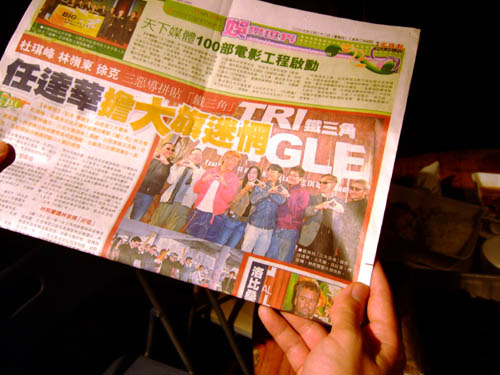
DB, still in Hong Kong:
Three directors of renown collaborate on a single film. Each is responsible for one part. But unlike your ‘portmanteau film,’ which tells separate stories (e.g., RoGoPaG or Paris je t’aime), in this project the same plot and characters are followed throughout. To make things interesting, the director of part one doesn’t tell the others what he’s planning; he simply presents a finished third. The second director has to take that further, and the man at the end has to wrap things up.
Hong Kong director Johnnie To came up with the idea for Triangle, and it’s nearing completion. Tsui Hark has finished the first section, Ringo Lam the second. Now To is shooting the conclusion, and he kindly invited Shelly Kraicer (Chinese movie expert), Todd Brown (of Twitchfilm.net), Antoine Thirion (of Cahiers du cinéma), and your obedient servant to a late-night shoot on Thursday. Milkyway mainstay Shan Ding was our guide.
I don’t have to tell you it was fun.
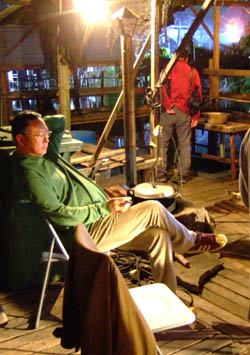
The setting is a rundown cafe perched on a swampy pond in the New Territories. The location is near the forest where the armored-car shootout takes place in Exiled. We saw To shoot a scene with Lam Suet, Louis Koo, and other actors meeting in the café. In this portion, Lam is sprawled on the floor.
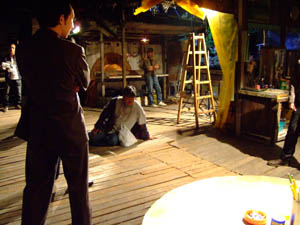
The scene climaxes with one actor dangling from a hole in the roof. You can see Mr. To in the lower right foreground watching the shot on his video assist, a monitor that shows what the camera sees. Maybe you can glimpse the shadowy assistant on the rooftop helping the actor hold on.
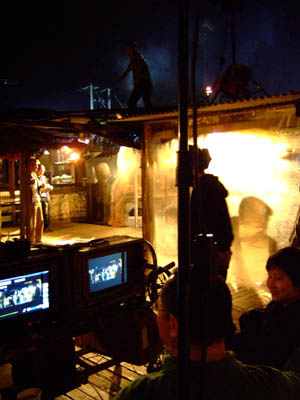
Meanwhile, the camera is shooting off on the right. It was a good opportunity to watch how To uses camera movement (constant in his films). Here you can see the camera dolly and the rail tracks it coasts along.
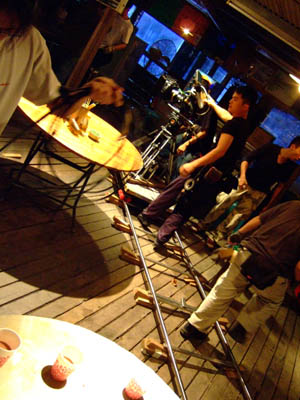
Louis Koo was also there, but not too visible. Simon Yam showed up for another scene, this one in the forest. Simon exudes charm and is warm and unpretentious. I first met him in 1995 at the Hong Kong Film Awards banquet, and he looks as handsome and mischievous as ever.
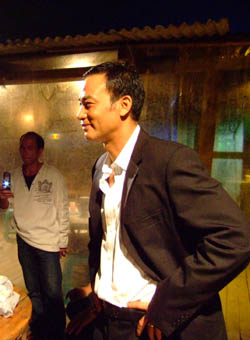
Kelly Lin arrived soon afterward. Another charmer, she told me she grew up in Santa Barbara and went to UC-Irvine. She’s been in a lot of recent HK movies.
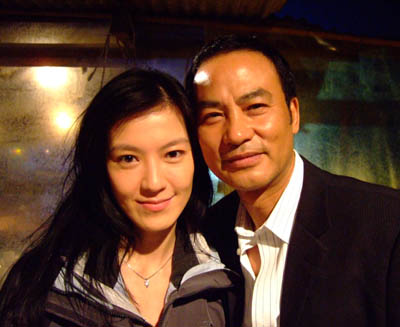
Later, shooting in the forest, the Milkyway team worked efficiently. We guests were parked on a little pier to watch from a distance.
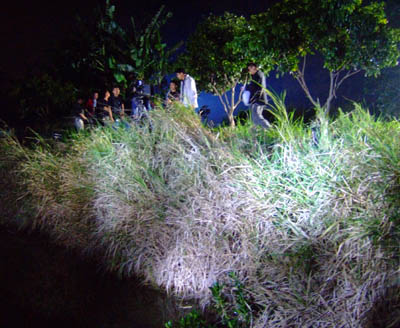
A crew member rustled a big sheet of plastic to create the impression of reflections from the water.
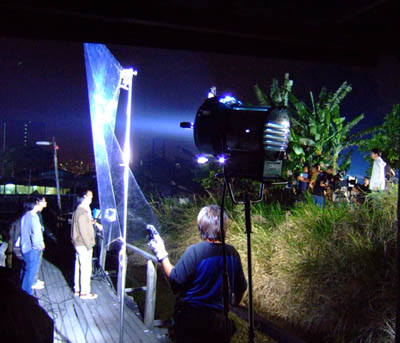
I’ve visited other Milkyway shoots, and each time I’ve been impressed by the sheer speed with which the work gets done. Everybody knows his/her job, and the staff changes camera and lighting setups very quickly. It also helps that HK films are almost always shot with no sound recording; everything is postdubbed. That yields the visual freedom, as well as the speed of production, of silent-era moviemaking.
In another echo of old production methods, To’s films sometimes use rooftop sets. Last year the set for the hotel in Exiled was erected on the top of the Milkyway building. Its Demy-like pastels looked very artificial in daylight.
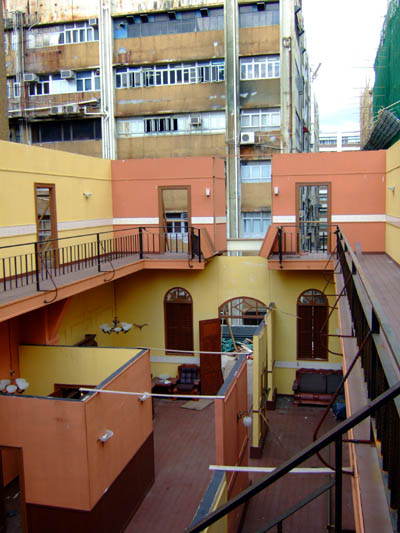
But check out the results on film, shot at night.
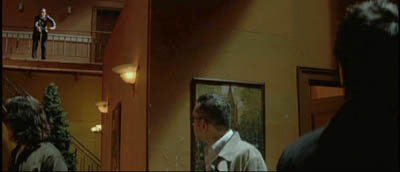
To’s art is furthered by his craftsmanship in shot composition. Composing in anamorphic (2.35:1), nearly always putting the camera on a tripod or dolly, he gets precise results with few lighting units. When I complained that all the new films I saw at Filmart were shot shakycam, Shan Ding reported a neat saying that HK DPs have. The handheld camera covers 3 mistakes: Bad acting, bad set design, and bad directing.
Unlike Hollywood filmmakers, who fiddle with the film by pushing and pulling and bleach bypassing and digital fixing in postproduction, Mr To just lets the film do its rich photochemical work. Expose it correctly, anchor the camera, and 35mm film stock can look gorgeous. His films show that we already have a high-definition moving-image medium, using not pixels but molecules. Motto: Let the emulsion be your friend.
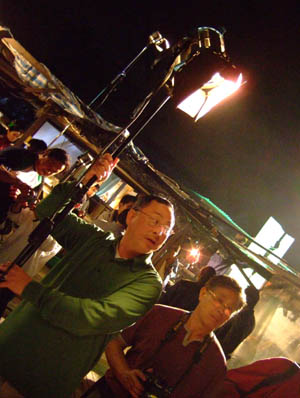
Shan also told me that the anamorphic format used by Milkyway is Technovision, an Italian system from the 1970s. These lenses yield lovely images with good depth of field, and To likes to fill up the wide frame with complicated blocking. Here’s an example from Exiled.
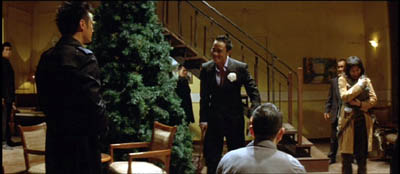
According to Rick Mitchell, Vittorio Storaro used Technovision lenses on Apocalypse Now and other pictures. It’s another way in which To is maintaining a heritage of quality—while also being economical. Milkyway owns the lenses, so no need to rent from local supply houses.
Mr To, Shan Ding, and the rest of the crew were very kind to us, even providing snacks and suggesting a group picture. Who could resist an offer like that?
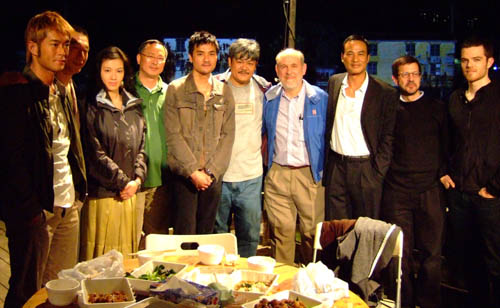
Later in my stay, I hope to report on another upcoming Milkyway film, the Simon/ Kelly pickpocket movie called The Sparrow.
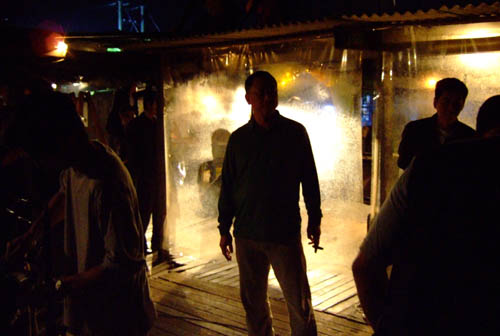
PS 24 March: I was told that Johnnie To came up with the idea for Triangle, but Vicki Rothrock reports for Variety that it was Tsui’s concept originally. Thanks to D. W. Hudson of GreenCine Daily for the link.
PPS 27 March: For Todd’s coverage of our set visit , go to Twitchfilm here.
PPPS 14 May: Per Variety, Triangle is a late addition to Cannes.
PPPPS 4 December 2010: Correction: The original entry claimed, inaccurately, that Mr. To used Techniscope, a two-perforation non-anamorphic format. The process being used is in fact Technovision, an anamorphic format. My apologies for the error.













